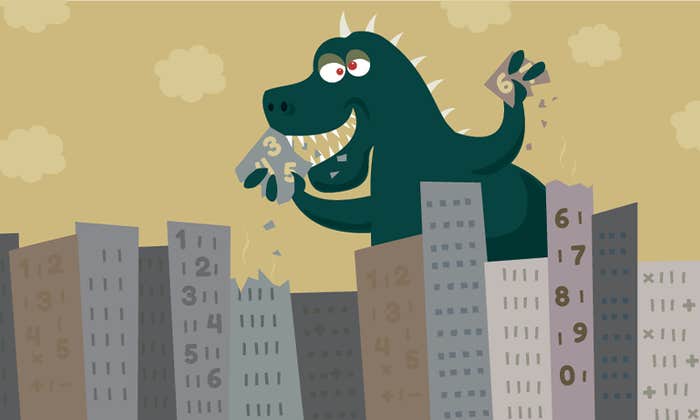Using stiff paper and transparent tape, Craig Kaplan assembles a beautiful roundish shape that looks like a Buckminster Fuller creation or a fancy new kind of soccer ball. It consists of four regular dodecagons (12-sided polygons with all angles and sides the same) and 12 decagons (10-sided), with 28 little gaps in the shape of equilateral triangles. There’s just one problem. This figure should be impossible. That set of polygons won’t meet at the vertices. The shape can’t close up.
Kaplan’s model works only because of the wiggle room you get when you assemble it with paper. The sides can warp a little bit, almost imperceptibly. “The fudge factor that arises just from working in the real world with paper means that things that ought to be impossible actually aren’t,” says Kaplan, a computer scientist at the University of Waterloo in Canada.

It is a new example of an unexpected class of mathematical objects that the American mathematician Norman Johnson stumbled upon in the 1960s. Johnson was working to complete a project started over 2,000 years earlier by Plato: to catalog geometric perfection. Among the infinite variety of three-dimensional shapes, just five can be constructed out of identical regular polygons: the tetrahedron, cube, octahedron, dodecahedron, and icosahedron. If you mix and match polygons, you can form another 13 shapes from regular polygons that meet the same way at every vertex—the Archimedean solids—as well as prisms (two identical polygons connected by squares) and “anti-prisms” (two identical polygons connected by equilateral triangles).
In 1966 Johnson, then at Michigan State University, found another 92 solids composed only of regular polygons, now called the Johnson solids. And with that, he exhausted all the possibilities, as the Russian mathematician Viktor Zalgaller, then at Leningrad State University, proved a few years later. It is impossible to form any other closed shapes out of regular polygons.
Yet in completing the inventory of polyhedra, Johnson noticed something odd. He discovered his shapes by building models from cardboard and rubber bands. Because there are relatively few possible polyhedra, he expected that any new ones would quickly reveal themselves. Once he started to put the sides into place, the shape should click together as a matter of necessity. But that didn’t happen. “It wasn’t always obvious, when you assembled a bunch of polygons, that what was assembled was a legitimate figure,” Johnson recalls.
They look tantalizingly open to solution, but ultimately prove impossible.
A model could appear to fit together, but “if you did some calculations, you could see that it didn’t quite stand up,” he says. On closer inspection, what had seemed like a square wasn’t quite a square, or one of the faces didn’t quite lie flat. If you trimmed the faces, they would fit together exactly, but then they’d no longer be exactly regular.
Intent on enumerating the perfect solids, Johnson didn’t give these near misses much attention. “I sort of set them aside and concentrated on the ones that were valid,” he says. But not only does this niggling near-perfection draw the interest of Kaplan and other math enthusiasts today, it is part of a large class of near-miss mathematics.
There’s no precise definition of a near miss. There can’t be. A hard and fast rule doesn’t make sense in the wobbly real world. For now, Kaplan relies on a rule of thumb when looking for new near-miss Johnson solids: “the real, mathematical error inherent in the solid is comparable to the practical error that comes from working with real-world materials and your imperfect hands.” In other words, if you succeed in building an impossible polyhedron—if it’s so close to being possible that you can fudge it—then that polyhedron is a near miss. In other parts of mathematics, a near miss is something that is close enough to surprise or fool you, a mathematical joke or prank.
Some mathematical near misses are, like near-miss Johnson solids, little more than curiosities, while others have deeper significance for mathematics and physics.
The ancient problems of squaring the circle and doubling the cube both fall under the umbrella of near misses. They look tantalizingly open to solution, but ultimately prove impossible, like a geometric figure that seems as though it must close, but can’t. Some of the compass-and-straight-edge constructions by Leonardo da Vinci and Albrecht Dürer fudged the angles, producing nearly regular pentagons rather than the real thing.

Then there’s the missing-square puzzle. In this one (above), a right triangle is cut up into four pieces. When the pieces are rearranged, a gap appears. Where’d it come from? It’s a near miss. Neither “triangle” is really a triangle. The hypotenuse is not a straight line, but has a little bend where the slope changes from 0.4 in the blue triangle to 0.375 in the red triangle. The defect is almost imperceptible, which is why the illusion is so striking.
A numerical coincidence is perhaps the most useful near miss in daily life: 27/12 is almost equal to 3/2. This near miss is the reason pianos have 12 keys in an octave and the basis for the equal-temperament system in Western music. It strikes a compromise between the two most important musical intervals: an octave (a frequency ratio of 2:1) and a fifth (a ratio of 3:2). It is numerically impossible to subdivide an octave in a way that ensures all the fifths will be perfect. But you can get very close by dividing the octave into 12 equal half-steps, seven of which give you a frequency ratio of 1.498. That’s good enough for most people.
Sometimes near misses arise within the realm of mathematics, almost as if mathematics is playing a trick on itself. In the episode “Treehouse of Horror VI” of The Simpsons, mathematically inclined viewers may have noticed something surprising: the equation 178212 + 184112 = 192212. It seemed for a moment that the screenwriters had disproved Fermat’s Last Theorem, which states that an equation of the form xn + yn = zn has no integer solution when n is larger than 2. If you punch those numbers into a pocket calculator, the equation seems valid. But if you do the calculation with more precision than most hand calculators can manage, you will find that the twelfth root of the left side of the equation is 1921.999999955867 …, not 1922, and Fermat can rest in peace. It is a striking near miss—off by less than a 10-millionth.
But near misses are more than just jokes. “The ones that are the most compelling to me are the ones where they’re potentially a clue that there’s a big story,” says University of California-Riverside mathematician John Baez. That’s the case for a number sometimes called the Ramanujan constant. This number is eπ √163, which equals approximately 262,537,412,640,768,743.99999999999925—amazingly close to a whole number. A priori, there’s no reason we should expect that these three irrational numbers—e, π, and √163—should somehow combine to form a rational number, let alone a perfect integer. There’s a reason they get so close. “It’s not some coincidence we have no understanding of,” says Baez. “It’s a clue to a deep piece of mathematics.” The precise explanation is complicated, but hinges on the fact that 163 is what is called a Heegner number. Exponentials related to these numbers are nearly integers.
Or take the mathematical relationship fancifully known as “Monstrous Moonshine.” The story goes that in 1978 mathematician John McKay made an observation both completely trivial and oddly specific: 196,884 = 196,883 + 1. The first number, 196,884, had come up as a coefficient in an important polynomial called the j-invariant, and 196,883 came up in relation to an enormous mathematical object called the Monster group. Many people probably would have shrugged and moved along, but the observations intrigued some mathematicians, who decided to take a closer look. They uncovered connections between two seemingly unrelated subjects: number theory and the symmetries of the Monster group. These linkages may even have broader, as yet ungrasped, significance for other subjects. The physicist Edward Witten has argued that the Monster group may be related to quantum gravity and the deep structure of spacetime.
Mathematical near misses show the power and playfulness of the human touch in mathematics. Johnson, Kaplan, and others made their discoveries by trial and error—by exploring, like biologists trudging through the rainforest to look for new species. But with mathematics it can be easier to search systematically. For instance, Jim McNeill, a mathematical hobbyist who collects near misses on his website, and Robert Webb, a computer programmer, have developed software for creating and studying polyhedra.
Near misses live in the murky boundary between idealistic, unyielding mathematics and our indulgent, practical senses. They invert the logic of approximation. Normally the real world is an imperfect shadow of the Platonic realm. The perfection of the underlying mathematics is lost under realizable conditions. But with near misses, the real world is the perfect shadow of an imperfect realm. An approximation is “a not-right estimate of a right answer,” Kaplan says, whereas “a near-miss is an exact representation of an almost-right answer.”
In this way, near misses transform the mathematician’s and mathematical physicist’s relationship with the natural world. “I am grateful for the imperfections of the real world because it allows me to achieve a kind of quasi-perfection with objects that I know are intrinsically not perfect,” Kaplan says. “It allows me to overcome the limitations of mathematics because of the beautiful brokenness of reality.”
Evelyn Lamb is a mathematician who specializes in complex analysis. She writes extensively on math and science. She blogs for the American Mathematical Society and for her own blog, “Roots of Unity.” @evelynjlamb
Lead image credit: Comaniciu Dan / Shutterstock


























